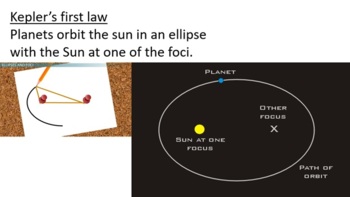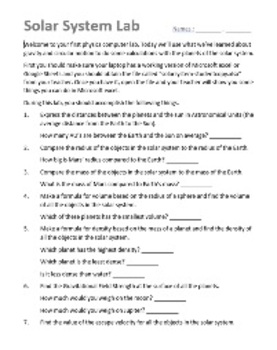High School Physics - Solar System Lab
STEM4U
2 Followers
Resource Type
Standards
CCSSMP5
NGSSHS-ESS1-4
Formats Included
- Zip
- Excel Spreadsheets
Pages
11 pages
STEM4U
2 Followers
Description
This is a computer lab for consolidating astronomy based concepts such as Kepler's laws, Universal gravitation, escape velocity and satellite motion. This package includes a powerpoint for introducing Kepler's laws, an excel file with the orbital elements of the planets, and a fill-in-the-blanks document that guides the students through the tasks of the lab. This is a good activity to do in a high school physics class that covers astronomy related topics. It also gives students good experience inputting formulas and creating scatter plots in microsoft excel.
Total Pages
11 pages
Answer Key
Included
Teaching Duration
1 hour
Report this resource to TPT
Reported resources will be reviewed by our team. Report this resource to let us know if this resource violates TPT’s content guidelines.
Standards
to see state-specific standards (only available in the US).
CCSSMP5
Use appropriate tools strategically. Mathematically proficient students consider the available tools when solving a mathematical problem. These tools might include pencil and paper, concrete models, a ruler, a protractor, a calculator, a spreadsheet, a computer algebra system, a statistical package, or dynamic geometry software. Proficient students are sufficiently familiar with tools appropriate for their grade or course to make sound decisions about when each of these tools might be helpful, recognizing both the insight to be gained and their limitations. For example, mathematically proficient high school students analyze graphs of functions and solutions generated using a graphing calculator. They detect possible errors by strategically using estimation and other mathematical knowledge. When making mathematical models, they know that technology can enable them to visualize the results of varying assumptions, explore consequences, and compare predictions with data. Mathematically proficient students at various grade levels are able to identify relevant external mathematical resources, such as digital content located on a website, and use them to pose or solve problems. They are able to use technological tools to explore and deepen their understanding of concepts.
NGSSHS-ESS1-4
Use mathematical or computational representations to predict the motion of orbiting objects in the solar system. Emphasis is on Newtonian gravitational laws governing orbital motions, which apply to human-made satellites as well as planets and moons. Mathematical representations for the gravitational attraction of bodies and Kepler’s Laws of orbital motions should not deal with more than two bodies, nor involve calculus.




